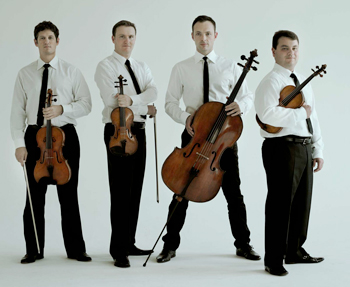by Daniel Hathaway

L-R: Ori Kam, Alexander Pavlovsky, Kyril Zlotnikov, Sergei Bresler
A few days before the Jerusalem Quartet’s concert at Plymouth Church on February 24, the ensemble’s home city got buried in a rare 10 inches of snow, with more in the forecast. Perhaps that brought Cleveland and Jerusalem into a special meteorological kinship as well as a musical one. Certainly, there were a lot of warm feelings being passed back and forth between musicians and audience during the quartet’s excellent performance on Tuesday evening on the Cleveland Chamber Music Society series.
Returning to the series for the sixth time, the Jerusalem offered music by Mozart, Schulhoff and Schumann in what has become the familiar quartet program structure of old-new-old. Not that Erwin Schulhoff is hot off the press, having had his life snuffed out by the Nazis during World War II — along with so many of Europe’s most promising composers — but his Five Pieces for String Quartet are so fresh and witty that they sound much newer than they are.
Finished in 1923 and premiered the following year at a new music festival in Salzburg, each movement is a take on a standard musical form: a Viennese Waltz (but written in 4/4 time), a Serenade (written in 5/8), a Czech dance (in two keys at once), an Argentine Tango (his personal view), and an eventful Tarantella (wildly chromatic). The Jerusalem players played them vivaciously, but with totally straight faces, increasing the effect of their wry humor.
The program began with the first of Mozart’s “Haydn” quartets, the G-major, K. 387, a four-movement work full of inventive ideas and rich details. The flow and ebb of the opening Allegro introduced the good-sized audience to the quartet’s signature sound — warm, expressive, and well-balanced, with fine inner support from the second violin and viola. The players made special moments out of episodes in the final Allegro by jettisoning vibrato — an effect that more quartets might explore.
Written during 1842, the year that the composer devoted almost exclusively to chamber music, Robert Schumann’s A-major Quartet, the last of three in his op. 41, shows the same sort of acquired mastery over a form that he set out to accomplish two years earlier when he concentrated on Lieder, and the year before, when he turned his attention to the symphony.
The delicious melodic sequences that adorn the opening movement received expressive treatment by the Jerusalem on Tuesday evening. They reacted like chameleons to the many vicissitudes of the “Agitato” that followed, caressed the lyrical melody of the Adagio, and drove the dotted rhythms of the finale home with wonderful intensity.
The audience was reluctant to let the Jerusalem Quartet call it a night, and the players were happy to offer a parting gift: the slow movement from the Debussy Quartet. Violist Ori Kam explained that since Schumann’s corner of Germany was more French-leaning in its tastes than Germanic, Debussy made an interesting connection with what had gone before. Whatever you wanted to make out of that, Debussy was a refreshing way to end a splendid concert.
Published on ClevelandClassical.com February 26, 2015.
Click here for a printable copy of this article


